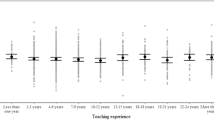Abstract
This article reports on a recent study on the use of instructional development to enhance the quality of university continuing education programs for professionals. As an instructional mode of continuing professional education, instructional development principles and procedures are potentially appropriate means for achieving and maintaining the quality and effectiveness of such programs. Although the application of instructional development in higher education has been studied by several researchers, there has been little research to address its application with regard specifically to the area of continuing professional education in higher education. Based on a national survey of continuing educators, the extent of use and the major factors associated with the use or lack of use of instructional development are presented and discussed. Three models of the use of instructional development developed through selected cases are provided.
Similar content being viewed by others
References
Bogdan, R.C. & Biklen, S.K. (1982).Qualitative research for education. Boston: Allyn and Bacon.
Diamond, R.M. (1980). Instructional development: One biased view (problems, issues, and the future).Educational Technology, 20(2), 51–54.
Dick, W. & Carey, L. (1985).The systematic design of instruction (2nd ed.). Glenview, Illinois: Scott, Foresman and Company.
Durzo, J.J. (1978). The organization and implementation of instructional development programs in higher education. In R.K. Bass & D.B. Lumsden (Eds.),Instructional development: The state of the art (pp. 111–140). Columbus, Ohio: Collegiate Publishing.
El-Khawas, E. (1985).Campus trends, 1984 (Report No. 65). Washington, D.C.: American Council on Education.
Eurich, N.P. (1985).Corporate classrooms: The learning business (A Carnegie Foundation Special Report). Princeton: The Carnegie Foundation for the Advancement of Teaching.
Grotelueschen, A.D. (1986, Fall). Challenges for continuing professional educators. Newsletter: a special joint issue of the National University Continuing Education Association and the American Association for Adult and Continuing Education.
Gustafson, K. & Bratton, B. (1984). Instructional improvement centers in higher education.Journal of Instructional Development, 7(2), 2–7.
Houle, C.O. (1980).Continuing learning the in the professions. San Francisco: Jossey-Bass.
Kozma, Robert B. (1985). A grounded theory of instructional innovation in higher education.Journal of Higher Education, 56, 301–319.
Lynton, E.A. (1981). A role for colleges in corporate training and development.Current Issues in Higher Education: Partnerships With Business and the Professions, (No. 3).
Martin, B.L. & Briggs, L.J. (1986).The affective and cognitive domains: Integration for research and instruction. Englewood Cliffs, New Jersey: Educational Technology Publications.
Molenda, M. (1987, March). An agenda for research on instructional development. Paper presented at the annual conference of the Association for Educational Communication and Technology, Atlanta, Georgia.
Moore, R.L. (1986). Continuing education from the academic affairs perspective.The Journal of Continuing Higher Education, 34(2), 2–7.
Nowlen, P.N. & Stern, M.R. (1981). Partnerships in continuing education for professionals.Current Issues in Higher Education: Partnerships With Business and the Professions, (No. 3).
Reigeluth, C.M. (1983). Instructional design: What is it and why is it? In C.M. Reigeluth (Ed.),Instructional-design theories and models: An overview of their current status (pp. 3–36). Hillsdale, New Jersey: Lawrence Erlbaum Associates.
Schon, D.A. (1983).The reflective practitioner, New York: Basic Books.
Shrock, S.A. (1985). Faculty perceptions of instructional development and the success/ failure of an instructional development program: A naturalistic study.Educational Communications and Technology Journal, 33(1), 16–25.
Singarella, T. & Boddy, G. (1986). Profit generation in continuing education centers in colleges and universities.The Journal of Continuing Higher Educations, 34(2), 12–17.
Taylor, R. (1986).An analysis of development and design models for microcomputer-based instruction. Unpublished doctoral dissertation, Syracuse University, New York.
Author information
Authors and Affiliations
Additional information
Philip L. Doughty is Associate Professor of Instructional Design, Development, and Evaluation and Director of the Division of Educational Development, Counseling, and Administrative Studies at Syracuse University.
The authors would like to express their appreciation to Dr. Margaret Holt, former chair of the NUCEA Survey Research Committee; Dean Frank Funk, Dr. David Krathwohl, and Dr. Roger Hiemstra, at Syracuse University; Dr. Paul Ilsley, University of Northern Illinois; and the editorial staff and reviewers ofInnovative Higher Education for their helpful comments and assistance.
Rights and permissions
About this article
Cite this article
Spuches, C.M., Doughty, P.L. A study of the use of instructional development in selected college/university continuing professional education programs. Innov High Educ 15, 83–99 (1990). https://doi.org/10.1007/BF00889740
Issue Date:
DOI: https://doi.org/10.1007/BF00889740




